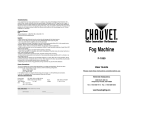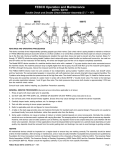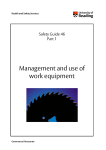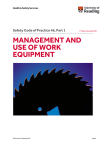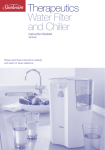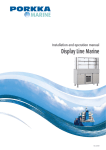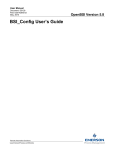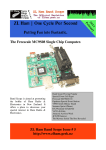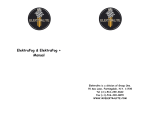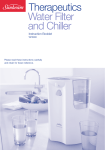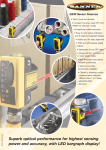Download Operators Manual - Wolf Laboratories
Transcript
DIXONS SURGICAL INSTRUMENTS LTD, 1 ROMAN COURT HURRICANE WAY, WICKFORD BUSINESS PARK WICKFORD, ESSEX, SS11 8YB, UK TEL: +44 (0)1268 764614 - FAX: +44 (0)1268 764615 EMAIL: [email protected] - WEB: http://www.dixons-uk.com ST 18 Aluminium Gas Model Operators Manual Issue 5 For correct operation of this autoclave it is essential that the chamber be filled with water up to the height of the studs before every use. Warning - All external body and lid surfaces are hot during and immediately after sterilisation. Lift or move the autoclave by the top handle only. 7. Illustration Notes Nut (2) (6) A B Draw-off Cock Aircock C Pressure Gauge D Safety Valve E Thermometer F Collared Wing G H Plain Wing Nut Drop Bolt (8) Foreword Before using this Dixons Portable Autoclave please read this booklet carefully. Please ensure that all persons likely to use this product are correctly trained in its use in accordance with these instructions. Your Dixons Portable Autoclave, operated in accordance with the manufacturers instructions, will give years of trouble free service without the need for any major servicing. 1. Installation Procedure 1.1 On receiving the autoclave remove all the cardboard protective covers. Unscrew the six Wing Nuts, which are holding the lid on, and remove the lid. Remove all other packaging materials from inside the autoclave. 1.2 Ensure that the following parts are included: Every Dixons Portable Autoclave has been manufactured to the highest quality standards by a company complying with BS EN ISO 9000 and is fully tested and ready for immediate use. · · · · · · · Dixons Portable Autoclaves are suitable for sterilisation of: · · · · · Laboratory equipment (glass and metal) Culture media Pharmaceutical preparations in sealed containers Surgical and Veterinary instruments Dressings and drapes For the sterilisation of dressings and drapes it is recommended that a Dressing Drum or Wire Mesh Basket be used. These are available as a part of the range of accessories. All Dixons Portable Autoclaves are particularly suitable for destructive sterilisation, as the operator is not restricted to a set cycle time. This can be adjusted to suit the application. This users manual consists of seven sections: 1. 2. 3. 4. 5. 6. 7. Installation Procedure Operation Sterilising Periods Maintenance Specification Record of Inspection Illustration Autoclave body and lid complete with all fittings as per the illustration in section 7. Inner liner. Pair of liner Carrying Handles. White silicone gasket in lid. Operators manual. Test certificate. Pack of TST indicator strips. 1.3 Ensure that no damage has occurred to any of the fittings paying special attention to the Pressure Gauge and Thermometer. 1.4 The autoclave is now ready for use. If the inspection revealed defects in the autoclave, specify below the necessary repairs or modifications which may be required: Inspection Completed Date Action Required Sign Date Sign 6. Record Of Inspection An annual safety check will normally be sufficient unless the autoclave is in very regular use. The date of the next examination should be clearly marked on the autoclave once the examination is completed. The purpose of this form is to provide a written record of inspection. It is merely a guide as to what to look for. It does not remove the need to routinely inspect and maintain the autoclave as described in section 4. Model Type: ST 18 Serial No: ___________________ Date of Examination Is the autoclave free from all signs of physical damage and distortion? Are the internal surfaces free from major 'pitting' (up to 1.5mm is acceptable)? Is the Silicone Gasket flexible, unperished and undamaged? Is the Pressure Gauge undamaged and does it read zero at atmospheric pressure? Is the Safety Valve undamaged, free moving and in working order? Are all the Wing Nuts and Drop Bolts undamaged and in working order? Are the Aircock and Draw-off Cock undamaged and in working order? Is a written set of instructions available for reference by users of the autoclave? Insert þ or ý as applicable position. The remaining 6 Plain Wing Nuts should now be lightly tightened in opposite pairs. This should be done as with the Collared Wing Nuts - one in each hand - until the slack is taken up. Now tighten up all the Wing Nuts in opposite pairs Collared Wing Nuts first. Normal finger tightness is adequate. Inspectors Signature 2.4 Close the Draw-off Cock and open the Aircock approximately 6 turns. 2.5 Turn on the gas or hotplate to a high power setting. 2.6 When the water begins to boil, steam will start to emit from the Aircock. It will splutter at first. Close the Aircock once it has stopped spluttering and a clean jet of steam is visible. It is imperative that a clean jet of steam is visible before closing the Aircock as this ensures all the air in the autoclave is expelled. Air pockets in the autoclave will cause sterilisation to be incomplete. It is advisable to use some form of sterilisation test e.g. the TST indicator strips supplied. 2.7 The pressure and therefore temperature will now continue to rise until it reaches the preset level and the Safety Valve releases the excess pressure. 2.8 The gas or hotplate should now be turned down to a low power setting. 2.9 It is at this time that the sterilisation period begins. Section 3 deals with sterilisation periods. 2.10 When the sterilisation period is complete, turn off the gas or hotplate. Depending on the materials being sterilised, see section 2.11 or 2.12. 2.11 Bottles or other sealed vessels containing liquid - do not, under any circumstances, open the Draw-off Cock or the Aircock or release pressure from the autoclave in any manner. To release pressure from the autoclave at this point 2. Operation Please read these operating instructions before using the autoclave to avoid any chance of misuse. The autoclave is factory set to run at 121ºC. This is the maximum setting, which is suitable for most purposes. A lower setting can be used if required. Many materials can be autoclaved at 121ºC. These include most metals, glass, silicone rubber and many plastics. If in doubt, consult the manufacturer of the instrument or equipment concerned as the manufacturer of the autoclave does not accept liability for damage of this nature. 2.1 Remove the Inner Liner. Fill the chamber of the autoclave with water up to the height of the studs. 2.2 Articles to be sterilised should be placed into the Inner Liner, a Wire Mesh Basket or a Bottle Rack. To sterilise porous loads (i.e. dressings and drapes) it is recommended that a Dressing Drum be used. The container should not be packed tightly, especially when dressings are being sterilised. It is important that steam can circulate freely. Place the Inner Liner / Wire Mesh Basket / Bottle Rack / Dressing Drum inside the autoclave. 2.3 Locate the two Drop Bolts without Wing Nuts and move these to the upright position. Check that the Lid Gasket is correctly seated in its groove on the underside of the lid. Place the lid on the autoclave so that the 2 Collared Wing Nuts are over the upright Drop Bolts. Lightly tighten down the 2 Collared Wing Nuts as a pair - one with each hand - until the slack is taken up in them. Swing up the remaining 6 Drop Bolts into could cause the containers to explode. Allow the autoclave to cool until the Thermometer shows 80ºC or less. 5. Specifications Model Type: ST 18 Capacity: 14 litres Internal Diameter: Internal Height: 280mm 230mm Overall Width: Overall Depth: Overall Height: 420mm 400mm 410mm Net Weight: 11.5Kg Chamber Material: Die Cast Aluminium LM25 Heat Source: External Heat Source Bottled Gas Burner Mains Gas Burner Kerosene Stove Electric Hot Plate Design Pressure: H T Pressure: S W Pressure: 1.3 bar (18 psi) 2.0 bar (30 psi) 1.3 bar (18 psi) Complies With: H&SE PM73 (Lid Locking) PED - 97/23/EC adjuster clockwise, and to lower the pressure (and therefore the temperature) turn it anti-clockwise. The autoclave should be left to settle for about 1 minute after each adjustment. When the desired pressure (and therefore temperature) setting is reached, tighten the locking grub screw back up to prevent the slotted adjuster moving and replace the top cap. The maximum setting allowed is 121ºC - 1.0 bar (15 psi). Maintenance - Remove the top cap, undo the locking grub screw and unscrew the Slotted Adjuster as above. Remove the spring and spindle to expose the Silicone Seal. Clean all parts and check the Silicone Seal for wear. Replace if necessary. Reassemble using a small smear of Autoclave Grease on the spindle and threads. Set the Safety Valve to the desired setting as described in the relevant section above. 2.14 2.12 2.13 Dressings, instruments and apparatus - (providing the apparatus does not have sealed glass containers holding liquid). Warning - The water and steam that is released from the autoclave at this stage is extremely hot. Wear suitable protective equipment at this stage. Place a suitable receptacle beneath the Draw-off Cock and open the Drawoff Cock to release water and steam under pressure from the autoclave. When steam ceases to emit, close the Draw-off Cock and allow the autoclave to cool until the Thermometer shows 80ºC or less. During the cooling period a partial vacuum will form inside the autoclave. This will help in drying the contents. When the autoclave is cooled, the Aircock should be opened approximately 6 turns. Check that the Pressure Gauge is reading zero. Unscrew the 6 Plain Wing Nuts in opposite pairs - one in each hand - 2 full turns. Now unscrew the 2 Collared Wing Nuts as a pair - one in each hand - 2 full turns. This will allow the lid to rise to a safe position, where it is still held captive, but has enough clearance to release any residual pressure still in the autoclave. Unscrew the 6 Plain Wing Nuts fully in opposite pairs - one in each hand - and swing down the Drop Bolts. Unscrew the 2 Collared Wing Nuts completely as a pair - one in each hand - and remove the lid. Do not attempt to remove the lid until all the Wing Nuts are released. Remove the sterilised contents. 3. Sterilising Periods The following times apply to a loosely packed load. Dressings in particular should not be packed tightly as steam will not penetrate. Wire Mesh Baskets or Dressing Drums are recommended for this application. When large packs of dressings or large volumes of liquid are being sterilised, it is advisable to allow a further 10 minutes sterilisation time. This ensures adequate penetration of the materials by steam and heat. Use these times as a general guide only - always use a sterilisation test e.g. the TST indicator strips supplied. Instruments and Equipment Dressings and Drapes Liquid in Sealed Containers (0ml - 50ml) Liquid in Sealed Containers (50ml - 100ml) Liquid in Sealed Containers (100ml - 200ml) Culture Media (up to 1 litre) 121ºC 121ºC 121ºC 121ºC 121ºC 121ºC Notes on sterilisation of Culture Media: 1. Always follow the manufacturer's instructions. 15 minutes 30 minutes 20 minutes 20 minutes 20 minutes 15 minutes 2. 3. 4. 5. Use volumes up to 1 litre. Use similar volumes in the same load. After cycle test for sterility. Check microbiological performance before use. 4. Maintenance UK users - this autoclave comes within the scope of 'The Pressure Systems and Transportable Gas Containers Regulations 1989' and should be inspected and maintained accordingly. General maintenance should be carried out by a competent person only, as and when deemed necessary. 4.1 Lid Gasket - Check the white silicone Lid Gasket for distortion or wear and tear. The Lid Gasket is located in the groove on the underside of the lid. Check that it has not become brittle. Replace the Lid Gasket with a new one if necessary. 4.2 Body Rim - Check the rim of the body where the Lid Gasket seats for damage to the metal casting which would cause the lid seal to leak. If the damage is only minor, then the rim can be repaired by filing and smoothing with emery cloth. Major damage should be referred to the manufacturer or a qualified service engineer. 4.3 Draw-off Cock - Check the Draw-off Cock for signs of leaking around the seals and from the valve. Replace the seals or complete Draw-off Cock with a new one if necessary. 4.4 Cleaning - The use of alkalis (e.g. sodium bicarbonate) may cause corrosion of the pot and lid and should therefore be avoided. Use normal household detergent to clean the interior of the autoclave. 4.5 Safety Valve Adjustment and Maintenance - The Safety Valve is factory set to hold a temperature of 121ºC. This is a maximum, but can be adjusted if required to a lower setting by a competent person only. Adjustment - Unscrew the top cap and loosen the locking grub screw. Set a gap of about 4mm between the slotted adjuster and the top of the body. Bring the autoclave up to working pressure. Turn the gas or hotplate down to a low power setting. Warning - The Safety Valve will be hot at this point. The pressure at which the Safety Valve releases steam can now be adjusted by turning the slotted adjuster. To raise the pressure (and therefore the temperature) turn the slotted










